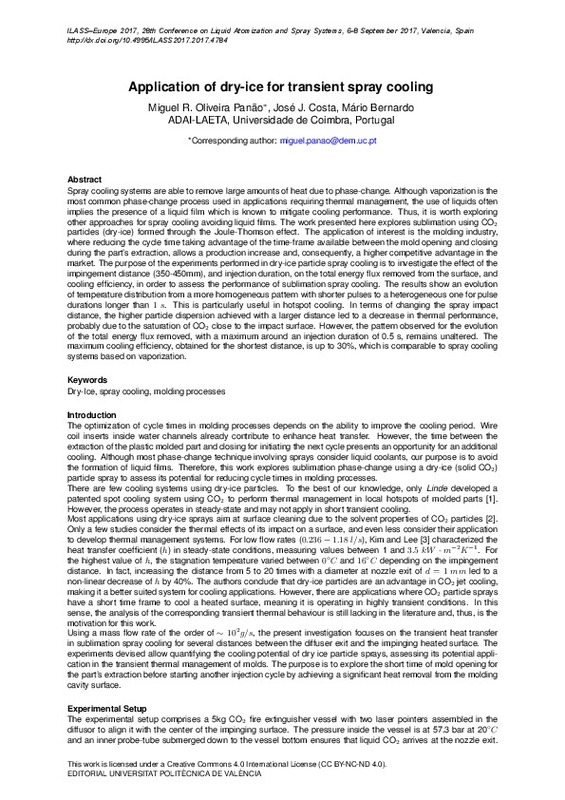JavaScript is disabled for your browser. Some features of this site may not work without it.
Buscar en RiuNet
Listar
Mi cuenta
Estadísticas
Ayuda RiuNet
Admin. UPV
Application of dry-ice for transient spray cooling
Mostrar el registro sencillo del ítem
Ficheros en el ítem
| dc.contributor.author | Panao, Miguel
|
es_ES |
| dc.contributor.author | Costa, José
|
es_ES |
| dc.contributor.author | Bernardo, Mário
|
es_ES |
| dc.date.accessioned | 2018-05-09T09:25:00Z | |
| dc.date.available | 2018-05-09T09:25:00Z | |
| dc.date.issued | 2017-07-28 | |
| dc.identifier.isbn | 9788490485804 | |
| dc.identifier.uri | http://hdl.handle.net/10251/101593 | |
| dc.description.abstract | [EN] Spray cooling systems are able to remove large amounts of heat due to phase-change. Although vaporization is the most common phase-change process used in applications requiring thermal management, the use of liquids often implies the presence of a liquid film which is known to mitigate cooling performance. Thus, it is worth exploring other approaches for spray cooling avoiding liquid films. The work presented here explores sublimation using CO2 particles (dry-ice) formed through the Joule-Thomson effect. The application of interest is the molding industry, where reducing the cycle time taking advantage of the time-frame available between the mold opening and closing during the part’s extraction, allows a production increase and, consequently, a higher competitive advantage in the market. The purpose of the experiments performed in dry-ice particle spray cooling is to investigate the effect of the impingement distance (350-450mm), and injection duration, on the total energy flux removed from the surface, and cooling efficiency, in order to assess the performance of sublimation spray cooling. The results show an evolution of temperature distribution from a more homogeneous pattern with shorter pulses to a heterogeneous one for pulse durations longer than 1 s. This is particularly useful in hotspot cooling. In terms of changing the spray impact distance, the higher particle dispersion achieved with a larger distance led to a decrease in thermal performance, probably due to the saturation of CO2 close to the impact surface. However, the pattern observed for the evolution of the total energy flux removed, with a maximum around an injection duration of 0.5 s, remains unaltered. The maximum cooling efficiency, obtained for the shortest distance, is up to 30%, which is comparable to spray cooling systems based on vaporization. | es_ES |
| dc.description.sponsorship | The authors would like to acknowledge to the financial support of project EMCool - Efficient Mold Cooling (POCI01-0247-FEDER-011375) | es_ES |
| dc.format.extent | 7 | es_ES |
| dc.language | Inglés | es_ES |
| dc.publisher | Editorial Universitat Politècnica de València | es_ES |
| dc.relation.ispartof | Ilass Europe. 28th european conference on Liquid Atomization and Spray Systems | es_ES |
| dc.rights | Reconocimiento - No comercial - Sin obra derivada (by-nc-nd) | es_ES |
| dc.subject | Dry-Ice | es_ES |
| dc.subject | Spray cooling | es_ES |
| dc.subject | Molding processes | es_ES |
| dc.title | Application of dry-ice for transient spray cooling | es_ES |
| dc.type | Capítulo de libro | es_ES |
| dc.type | Comunicación en congreso | es_ES |
| dc.identifier.doi | 10.4995/ILASS2017.2017.4784 | |
| dc.relation.projectID | info:eu-repo/grantAgreement/EC/COMPETE2020/POCI01-0247-FEDER-011375/EU/Efficient Mold Cooling/EMCool | |
| dc.rights.accessRights | Abierto | es_ES |
| dc.description.bibliographicCitation | Panao, M.; Costa, J.; Bernardo, M. (2017). Application of dry-ice for transient spray cooling. En Ilass Europe. 28th european conference on Liquid Atomization and Spray Systems. Editorial Universitat Politècnica de València. 147-153. https://doi.org/10.4995/ILASS2017.2017.4784 | es_ES |
| dc.description.accrualMethod | OCS | es_ES |
| dc.relation.conferencename | ILASS2017 - 28th European Conference on Liquid Atomization and Spray Systems | es_ES |
| dc.relation.conferencedate | September 06-08,2017 | es_ES |
| dc.relation.conferenceplace | Valencia, Spain | es_ES |
| dc.relation.publisherversion | http://ocs.editorial.upv.es/index.php/ILASS/ILASS2017/paper/view/4784 | es_ES |
| dc.description.upvformatpinicio | 147 | es_ES |
| dc.description.upvformatpfin | 153 | es_ES |
| dc.type.version | info:eu-repo/semantics/publishedVersion | es_ES |
| dc.relation.pasarela | OCS\4784 | es_ES |
| dc.contributor.funder | European Commission |








